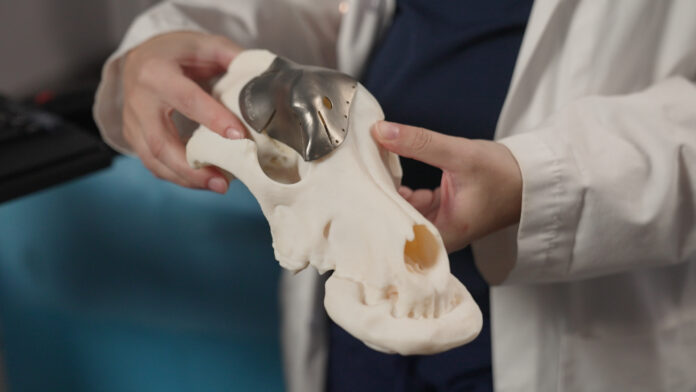In 2017, Kris Depowski was petting her dog Murphy when she noticed a bump on the top of his head.
It was hard, about the size of a golf ball, and as she recalls, “it appeared out of nowhere.”
Soon after, Depowski got some scary news.
The bump was a rare form of cancer, unresponsive to either radiation or chemotherapy. And the bump itself was just the tip of the iceberg. The majority of Murphy’s tumour was growing inwards, into his sinuses and back towards his brain. Murphy’s only option was to have it surgically removed, along with nearly half of his skull — an incredibly invasive and risky procedure.
But there was hope, even though it sounded like science fiction: a 3D printer could save Murphy’s life.
Kris Depowski and her dog Murphy at home in Buffalo, NY.
Tom Vetter/Global News
Murphy’s miracle was the result of a pioneering surgical approach by Dr. Michelle Oblak of the Ontario Veterinary College, at the University of Guelph. It was Dr. Oblak’s second such surgery: the first being a small dachshund named Patches, whose form-fitting, 3D-printed titanium implant replaced close to 70 per cent of her skull.
And like with Patches, Murphy’s surgery was a success.
Today, Depowski is grateful to Dr. Oblak and the surgical team that used 3D printing to save her pet. “When I talk about Murphy, I just call him my ‘bionic dog’. Because that’s what he is. Half of his skull is bionic.”
Together, Murphy and Patches are proof that 3D printing (also known as additive manufacturing) is ready for prime-time. No longer just a gimmick, 3D printing might hold the answers to many complex problems.
From supply chains and medicine to manufacturing and construction, many experts say we’re hurtling toward a brave new world, where 3D printers will change nearly every aspect of the way we live.
Dr. Michelle Oblak of the Ontario Veterinary College holds an exact replica of Murphy’s skull and tumour, which were created by a 3D printer using Murphy’s CAT scans as a template.
Brent Rose/Global News
That may sound like hype. And if anyone is skeptical about that kind of claim, it’s Tharwat Fouad. He started Mississauga-based Anubis 3D in 2012, around the same time as a previous media storm hit his industry, and he still remembers the futuristic headlines of the day. They preached about us all 3D printing everything, from our dishes to our cars, and never needing to go to a store again.
But all that attention backfired, because according to Fouad, the technology wasn’t ready.
This time, however, it is. “Right now, it’s started to be accepted as a mainstream manufacturing process.” says Fouad. “I think we’re just scratching the surface here.”
Since 2012, the 3D printers at Anubis 3D have pumped out over 10 million parts. They’re specialized for industrial applications, where quality standards are incredibly strict. Every piece gets run through a gauntlet of tests before it’s certified. So Anubis 3D is just like any other machine shop, with one major exception: their lightning-fast speed.
“The time it takes to design for additive [manufacturing], when you’re designing a complex part, is longer. But the actual manufacturing time is a lot less,” says Fouad. “The manufacturing process in additive manufacturing is days: same day, two days at most. And if you go out with the same equivalent part to a CNC [machine] shop and say, ‘I need this part’, it’s a couple of weeks.”
That capacity to significantly increase production speed is turning heads, because in the manufacturing industry, time is money. But money is also money. And the fact that 3D printing also brings increased automation could save a lot of dollars when it comes to labour.
Tharwat Fouad, Founder of Anubis 3D, is a Canadian pioneer and leader in industrial-grade 3D printing.
Global News/Brent Rose
“We have two people running three or four machines, and only for 8 hours a day,” says Fouad. “And the machines are running 24 hours. So the labour factor in this technology is very small.”
In North America, labour makes up a huge chunk of manufacturing budgets. Which is why so much of the industry has been farmed out overseas. But thanks to 3D Printing, all that could change. In fact, Fouad says, it can eliminate the advantage of overseas manufacturing with its wait times and shipping costs. Its major allure, he tells clients, is, “You’re not going to wait for a part to come to you from China.”
That’s why so many are hopeful that 3D printing will make the manufacturing industry a local industry once again.
It’s already happening. And although this clearly won’t lead to a new hiring boom, it could have major implications for our environment.
This concept photo by Desktop Metal shows an imagined ‘Factory of the Future’ with multiple rows of their full-sized Production System printers. The Production System is a high-speed metal 3D printer, designed for mass production.
Courtesy Desktop Metal
The current model — shipping raw materials to the opposite side of the world to be turned into goods and then shipped back — has some major flaws. An enormous carbon footprint is one of them.
But 3D printing, if widely adopted, could eliminate global supply chains as they currently exist, along with the bottlenecks that plague them.
A global 3D printing network could bring a new paradigm of on-demand manufacturing. No more armadas of planes, trains, and container ships carrying cargo around the globe. No more huge, specialized factories. And no more massive warehouses to house unused stock indefinitely.
Instead, “parts” could be transported digitally as files over the internet. And companies anywhere could download those files and 3D print them, producing only what they need when they need it.
And the eco-benefits of 3D Printing extend right down to the way the technology actually works. The word ‘additive’ being key here: with additive manufacturing, parts are built up from scratch, one layer at a time.
This photo shows an example of a tiny, but incredibly detailed 3D printed metal component made by Desktop Metal. In the photo, the individual print layers are clearly visible.
Courtesy Desktop Metal
Traditional manufacturing methods like machining, however, are subtractive — meaning they start with a large chunk of raw material, and whittle it away until only the part that’s needed is left. But it’s costly: up to 70 per cent of the material can be simply lost as waste.
Then, there are the more refined benefits of 3D printing, including the ability to easily build parts with incredibly complex geometries. And something called topography optimization, which means reducing the amount of material in a component, to make it as light as it can possibly be, while retaining all the necessary strength.
3D printing, explained
That incredible efficiency at reducing material and weight has given 3D printing a strong foothold in the aerospace industry, where every gram shaved equals fuel saved.
The Airbus A350 has over 1,000 3D-printed parts, and Elon Musk’s SpaceX has even used the technology to build mission-critical components for spacecraft.
The combustion chamber of SpaceX’s SuperDraco rocket engine, found on the Crew Dragon capsule, was fabricated entirely with 3D printing, using a metal superalloy known as Inconel.
The SuperDraco rocket engine is a fully 3D printed component found on the SpaceX Crew Dragon capsule.
SpaceX
Not only is this material incredibly strong, but 3D printing also enables a dense network of intricate cooling channels to be built directly into the part itself. This contrasts dramatically with traditional combustion chambers, which have many individual pipes welded together, and results in massive time savings, and up to one thousand fewer parts.
All of these advantages strung together have some, like Dr. Tim Minshall, professor of Innovation at the University of Cambridge, touting 3D printing as one of the key elements of the Fourth Industrial Revolution, with the same potential impact on society as the rise of steam power, mass production, and the digital age.
That’s why the industry is poised for exponential growth. In 2017, 3D printing was only about a $7.3-billion industry, but that number is forecast to reach $100 billion by 2028.
At Anubis 3D, Fouad shows off a component printed by his team that encapsulates the magic of this technology. It has multiple, interconnected, moving parts — tiny gears and shafts — all of which are printed together and able to rotate right out of the machine.
Each of the red plastic octagon-shaped components in this photo are printed by Anubis 3D, and showcase the ability of 3D printers to manufacture multiple interconnected, moving parts simultaneously. All of the internal gears and shafts seen here are able to rotate right out of the machine.
Courtesy: Anubis 3D
“Moving parts in a sub-assembly, printed as one piece,” says Fouad. “Those are things … that are impossible to do with machining.”
Indeed, 3D printing has the potential to do many things long considered impossible. And that has implications far beyond the factory floor, to just about every industry on Earth.
Across the country, near the small BC town of Nelson, another Canadian company is making huge waves in the world of construction.
They’re using a super-sized 3D printer to transform the way houses are currently built.
“The construction industry is one of the largest industries in the world, and it’s ripe for automation” says Jim Ziemlanski.
He’s a co-founder of Twente Additive Manufacturing, and a firm believer that everyone deserves a place to call home.
Jim Ziemlanski of Twente Additive Manufacturing in front of their Fibonacci House – Canada’s first fully 3D printed home.
Cory Horton/Global News
“Nelson’s definitely seeing the same type of housing shortage that we’re hearing about across the country, and around the world.”
Thanks to a massive disconnect between housing supply and demand, and a pandemic-induced two-year-long near-vertical surge in pricing, in February 2022, the average cost of a home in Canada hit an all-time high of $816,720. And record-breaking prices have locked many out of the housing market completely.
But at Twente’s R&D facility, their specially built 3D Printer may hold a key. It uses a large robotic arm to print concrete walls, and entire buildings, one layer at a time.
Ziemlanski stands next to the machine while it prints, and gives a play-by-play of the process. “The material comes through the concrete hose to the six-axis robot, which positions our nozzle to deposit the material correctly for the wall we’re building.”
Twente Additive Manufacturing’s six-axis robotic arm is the centerpiece of their 3D concrete printing system. It can be programmed to move in precise, predetermined patterns, in order to build walls and other 3D structures one layer of concrete at a time.
Cory Horton for Global News
The concrete itself is formulated to be low-flow, so it holds its shape once it’s laid down, which removes the need for concrete forms. That alone saves time, energy, and money on the worksite. But it’s the automation that truly saves the day.
“You know, it’s like a photocopier.” says Ziemlanski with a chuckle. “You can hit copy, copy, as much as you like.”
Automation — once again — cuts down on labour. It also improves the repeatability and predictability of the build.
“The very nature of digital fabrication means that there’s a lot of eliminated mistakes,” says Ziemlanski. “I think pretty much anybody who’s built a home will know that there’s cost overruns. And with 3D concrete printing, you can be confident in your timelines and your budget.”
The Fibonacci House in Proctor, BC is Canada’s first fully 3D printed home.
Cory Horton for Global News
Twente designed and built the first fully 3D Printed home on Canadian soil in 2020, as a proof of concept that their technology works at scale. More recently, they’ve teamed up with World Housing, an international NGO, to 3D print a small community near Nelson, B.C., consisting of five homes that are a similar shape and size.
And this high-speed building strategy has also grabbed the attention of a B.C. community that’s in need of some new homes, fast.
Merritt, B.C. was devastated in 2021, first by fires, and then by floods, and many homes were destroyed. Now, they’ve brought in Twente to help them rebuild, and to house some of the many people who were displaced.
At under 500 square feet each, the homes would be categorized as ‘tiny,’ and for each one, the entire frame will only take about 12 hours to print, so they’ll create a very affordable living option for people in need.
The Merritt project is moving fast, and the home design is nearly finalized. The goal is to have 20 new homes printed, and 20 families housed before 2023.
A view inside the Fibonacci House showing the exposed, printed concrete interior walls. The ability to leave the walls ‘unfinished’ is another selling feature of this technology, as the installation of traditional wall coverings like drywall can be a major investment of both time and money during construction.
Courtesy Twente Additive Manufacturing
Cleary, no single solution will dig us out of the housing hole, but if 3D printing lets us build more homes, easier, faster, and cheaper, it can only help.
And the most far-out fix that this technology may offer deals with a shortage of a very different kind.
“The current organ shortage is very serious,” says Dr. Anthony Atala of the Wake Forest Institute for Regenerative Medicine in North Carolina. “In fact, over a 10-year period, the number of patients in the transplant list has gone up tenfold. And that’s because we’re living longer. And as we live longer, our organs tend to fail more.”
Dr. Anthony Atala of the Wake Forest Institute for Regenerative Medicine is a pioneer in the use of 3D printers to bioengineer lab-grown tissues and organs.
Nathan Petersen for Global News
To combat that crisis, Dr. Atala’s team has created state-of-the-art 3D printers that can print living human tissues — and one day, in the not-too-distant future, entire organs that function just like our own.
The printers use a special bio-gel as their raw material. It’s a thick, clear fluid, enriched with nutrients and seeded with living human cells. As it’s laid down, layer by layer, in any shape desired, it forms a 3D scaffolding for those cells to multiply and grow.
Bioengineered organs are a concept that predates 3D printing. In 1999, Dr. Atala was behind the very first successful lab-grown organ transplants in the world. His team took cells from the malfunctioning bladders of seven children with spina bifida and used them to grow thin sacs of tissue that were then grafted in place.
But bladders are classified as ‘hollow’ organs, and are relatively simple to bioengineer when compared to ‘solid’ organs like hearts, livers, kidneys, and lungs.
One of the state-of-the-art ‘bioprinters’ at the Wake Forest Institute for Regenerative Medicine creates a solid 3D scaffold in the shape of a human kidney.
Courtesy WFIRM
According to Dr. Atala, “solid organs are the most complex to really create, mainly because there’s so many cells per centimeter compared to other tissue types. And because you have such a high volume of cells, you need much larger nutritional volumes going through that organ.”
Building a blood supply to the tissues deep inside these solid organs was impossible in the past. And without blood supply, tissues die. But here again, 3D printing is opening big doors.
“We print these cells layer by layer, one at a time” says Dr. Atala. “And by doing so, we also create this highway system, if you will, that brings nutrition to the central portion of that printed construct, allowing it to survive.”
In 2021, Dr. Atala’s team took another major leap forward in this quest, when they placed 1st and 2nd in a NASA sponsored competition to bioengineer vascularized tissue that could function for 30 days in the lab. Their entries were two samples of vascularized liver tissue, using two completely different 3D bioprinting methods to create.
Multiple examples of 3D printed scaffolds that mimic the shape of human organs. Scaffolding like these can be seeded with living cells, and provide a home for those cells to multiply and grow.
Courtesy WFIRM
Dr. Atala says “3D printing has definitely revolutionized some of our thinking behind how we can best accomplish our goals of bringing more and more tissues and organs to patients, in a reliable and safe manner.”
Based on that, and all of the other lessons above, there’s no doubt that 3D printing is here to stay.
The real question is what amazing new ability will this technology uncover next?
Murphy’s surgeon, Dr. Michelle Oblak, says the possibilities are infinite. “It’s really just limited by the imagination. So 3D printing really is unlimited. Which is incredible.”
An exact replica of Murphy’s skull, fitted with a custom made, 3D printed titanium implant.
Brent Rose/Global News



